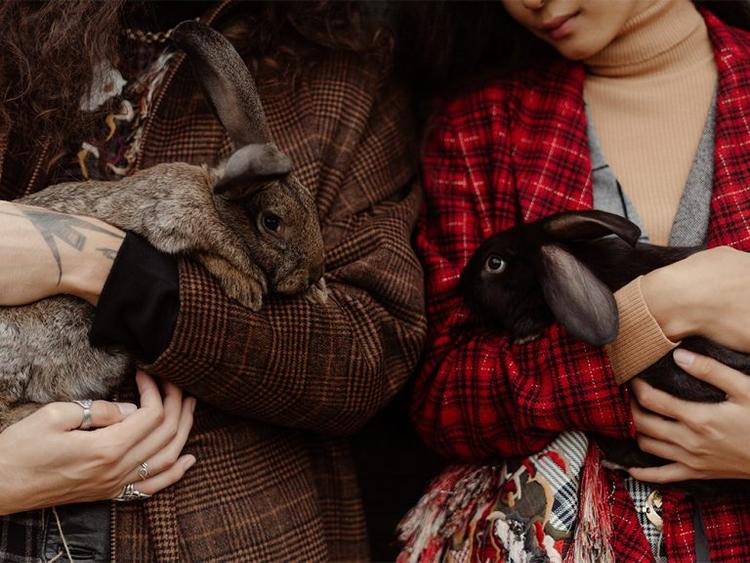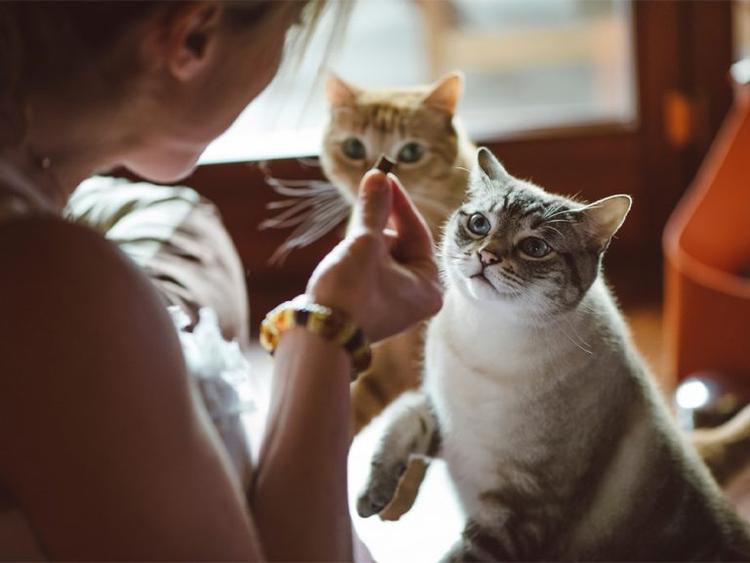Fostering Rabbits: Essential Tips for Prospective Foster Parents
What every prospective foster parent should know before jumping in
What every prospective foster parent should know before jumping in
by Katie Koschalk, | May 27, 2024

Lea Jones / Stocksy
Rabbits are the third-most abandoned animal, after cats and dogs. With so many misconceptions about rabbits, people often return or abandon them when they don’t meet expectations. Even worse, rabbits are frequently bought around Easter time, either gifted as pets or for holiday photoshoots, only to be surrendered shortly after. Fostering a rabbit offers a unique opportunity to provide temporary care to these displaced animals. But what does fostering a rabbit entail? Let’s jump into everything you need to know.
Fostering a rabbit involves temporarily caring for a rabbit while they wait for a permanent home. As a foster, you provide the rabbit with a safe, nurturing environment, meeting all of their daily needs, including food, water, shelter, and medical care if required. Being a foster requires compassion, patience, and a willingness to learn about rabbits’ needs and behaviors.
There are several reasons to become a foster parent.
Most animal shelters don’t have proper accommodations for rabbits (and animal shelters and rescue organizations operate at or near capacity, anyway). Additionally, rabbit-only rescues and shelters are not as common as cat and dog shelters, making space very limited. By fostering, you relieve some pressure on these facilities, reducing the risk of euthanasia for space.
Rabbits are naturally sociable animals, but those who have experienced neglect or abuse may be wary of humans. Fostering gives these rabbits a chance to live in a home setting, where they can gradually learn to build trust and confidence. Regular, gentle touch and interaction can help them adjust better to human presence, which is essential for making them more adoptable.
Fostering offers a unique chance to gain a deep understanding of rabbit behavior and care requirements. Through daily interactions, fosters become familiar with rabbit body language, the various sounds they make, and their specific dietary and health needs. This knowledge is especially valuable if you’re considering rabbit adoption, as it provides insight into whether a rabbit would be a good addition to your life. (Maybe you’ll even want to adopt the rabbit you foster! #fosterfailure)
As a foster, you play a pivotal role in the adoption process. By observing and interacting with the rabbit, you can assess their personality traits, likes, and dislikes. This information is crucial for the adoption staff to match the rabbit with an ideal home environment.
Additionally, this close observation allows fosters to identify any health or behavioral issues the rabbit may have, enabling the shelter to address these issues. This not only improves the rabbit’s chances of being adopted but also ensures they’re as healthy and well-adjusted as possible when they transition into a permanent home.
Daily greens (like lettuce, cilantro, and kale) are all fosters need to purchase for their foster rabbit, says Anna Reynoso, shelter manager at House Rabbit Society. This comes out to approximately $5-10 per week.
The organization you foster with typically supplies all other essentials. Reynoso says that their fosters will receive an exercise pen, litter box, litter, food pellets, hay, blankets, and bowls for food and water at no cost.
Most organizations, including House Rabbit Society and Bunny Buddies, also cover any veterinary care the foster rabbit may need during their stay.
Rabbits require daily care to maintain their health and happiness. As a foster parent, you’ll be responsible for the following.
Feeding a rabbit is fairly quick and easy. Naomi Mullinax, a foster parent with Bunny Buddies, says her daily feeding duties include:
Refilling the hay in the morning
Giving the rabbit a few small treats throughout the day
Feeding the rabbit dinner (pellets and greens)
Refilling and cleaning the water bowl as needed
Your foster bunny will need to reside in an enclosed indoor space. This can either be an exercise pen — which most organizations will provide you with — or a room with a door, such as a bathroom or guest room.
Both House Rabbit Society and Bunny Buddies require a minimum of 16 square feet for the primary enclosure. This should be separate from any other pets in the house, even if your pets are typically friendly with other animals. Rabbits are prey animals and tend to get easily frightened by perceived predators.
Place blankets, towels, or a low-pile rug on the enclosure’s floor to provide a cushion for the rabbit. The enclosure should also have all of the rabbit’s essentials, including a water bowl, hay for snacking, and a litter box. The litter box will need to be emptied and filled with clean litter every few days.
Your foster rabbit’s living space will need to be bunny-proofed. This entails hiding or blocking access to anything that could harm the bunny, such as:
Electrical cords, string, or carpet they could chew on or get tangled in
Small objects they could swallow
Household products like cleaning supplies, which are toxic to animals
Areas where they could get stuck, such as floor vents, spaces under doors, tables, or shelves
You should also put away anything you don’t want your foster bunny to nibble on. Reynoso explains that a rabbit’s teeth never stop growing, which is why they have the urge to chew on things.
“Most rabbits, if you give them toys and things to chew on, will behave themselves and only chew things they’re supposed to,” she says. “But of course, there are always some mischievous rabbits who may need some extra bunny-proofing done, like putting plastic covers on baseboards.”
Additionally, House Rabbit Society recommends that foster rabbits spend at least two hours each day outside their enclosure. Before you let your foster bunny out, put other animals away and bunny-proof whichever areas of your home the rabbit will have access to.
“Getting socialization in a foster home is so important, especially for rabbits who are shy or have other behavior needs. This helps them become more comfortable with people — and then more appealing to potential adopters,” says Reynoso.
For more reserved rabbits, Reynoso suggests spending time near them and allowing them to come to you. Once the rabbit consistently approaches you and seems comfortable, you can try giving them a gentle pet around the neck and shoulder area.
Positive interactions can be reinforced with a small treat, says Reynoso. “However, it’s important to moderate the quantity to avoid overfeeding.”
Rabbits typically don’t like interactive play like cats and dogs. So you can just let them hop around your home and explore. Keep an eye on your foster bunny, but as long as your living space is bunny-proofed, you can do other things around the house while they explore.
If you’re feeling crafty, Reynoso suggests making simple, homemade toys for your foster rabbit. A few good options include toilet paper rolls stuffed with hay, dig boxes, or simply plain, clean cardboard to nibble on.
Fosters are typically asked to provide photos and information about their foster rabbit’s personality that can be used in promotional materials to help find them a permanent home.
You’ll need to report any behavioral or health issues to the shelter promptly to ensure the rabbit receives the appropriate care, and that any potential problems are addressed early. This communication helps the organization provide ongoing support and ensures the best outcomes for the fostered rabbit.

William Daigneault / Unsplash
Fostering a rabbit can be a rewarding experience, but it also requires commitment, resources, and patience. Here are some important considerations to help you decide if fostering a rabbit is the right choice for you.
Reynoso explains that rabbits are crepuscular, which means they’re most active at the beginning and end of each day. “This makes them an ideal pet for people with 9-to-5 jobs since they will sleep for most of the day and then be active when someone comes home from work,” she says. (Of course, if you work from home or are otherwise home most of the time, your foster rabbit will surely appreciate the company.)
The time the foster rabbit will be in your care varies. House Rabbit Society asks for a two-week minimum commitment, but sometimes foster parents choose to extend their time. Mullinax says the longest she’s had a foster rabbit was about six months, and the shortest was around two months.
Be sure you have room in your home to safely accommodate your foster rabbit. Remember, they’ll need an indoor enclosure that’s at least 16 square feet and separate from other animals in the home.
While many organizations will provide essentials, there are some costs involved, such as providing daily greens. Some people also like to buy additional supplies for their fosters. House Bunny Society offers fosters a 15 percent discount at their store, the Hop Shop, if they want to purchase additional toys or treats while they foster.
As mentioned, other pets in your home must always be kept away from your foster rabbit. Think about whether or not this is a reasonable, achievable task.
Consider everyone in your household. All members should be comfortable with having a rabbit in the home and agree to maintain a safe environment for the foster.
Additionally, young children should not handle the foster rabbit by themselves. Bunny Buddies says that responsible children eight years or older can assist in the care under the guidance of an adult. If you have children who likely won’t abide by set guidelines, your home may not be the right fit for a foster.
Yes, most rabbit rescues are happy to teach you how to care for a foster rabbit. Most organizations, including House Rabbit Society and Buddies, also offer free virtual classes and/or online guides to provide information about how to prepare and care for a foster rabbit.
Plus, rescues take great care to match you with a rabbit who is right for your experience and skills. “We never want to send someone with a rabbit they aren’t equipped to take care of,” says Reynoso.
Yes, rabbits can become attached to their owners, especially if they’re handled gently and frequently from a young age.
When kept as pets, rabbits typically live between seven and 10 years, though some can live longer with proper care. The oldest rabbit on record lived to be 18.
Bunnies should ideally stay with their mother until they are at least eight weeks old. During this time, they nurse from their mother and gradually start to eat solid food, which is crucial for their development.
Ready to adopt a bunny? Going through a rabbit rescue is an excellent way to do this. You can also use Adopt a Pet’s search feature to find rabbits who need homes near you.

Katie Koschalk is a freelance writer based in Northern California. Fusing her love and knowledge of animals with her journalism degree and years of professional writing, Katie is dedicated to improving the lives of pets and their caretakers by sharing helpful and accurate information. When she’s not at her desk, you can find her exploring trails with her Aussie, Hunter, cooking plant-based meals, and talking to her two cats, Jax and Sadie, in really ridiculous voices.

Adoption Advice

Adoption Advice

Adoption Advice

Adoption Advice
These giant guinea pigs are smart and social, so what could go wrong? Read on to better understand why these animals don’t make good pets, and why they’re outlawed in several places.

Shelters & Rescue
The campaign returns for the 10th straight year in August.

Adoption Advice
Considering renting with pets? Read more to learn about renter policies and how to navigate them.

Adoption Advice

Adoption Advice
Is the responsibility of taking care of your pet causing you to worry about your budget? Rest assured, there are a number of ways to minimize this financial stress.

Shelters & Rescue

Behavior & Training
